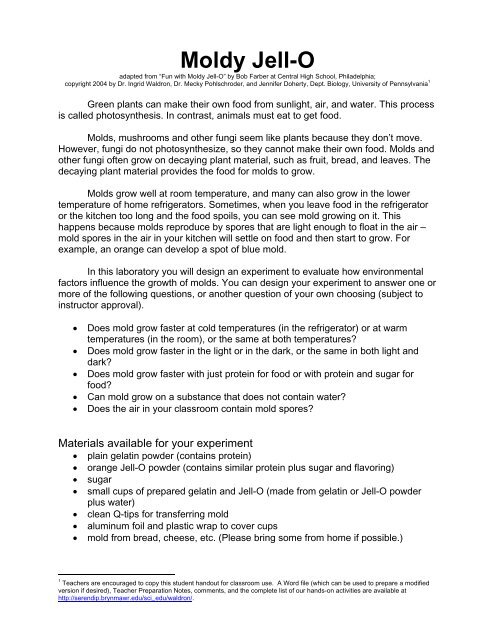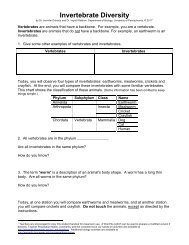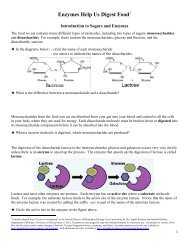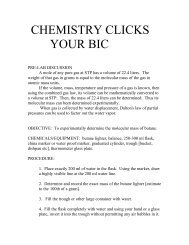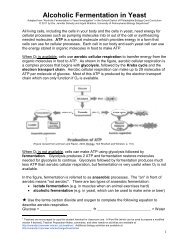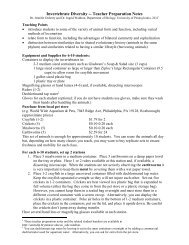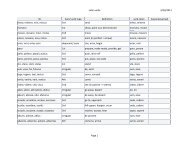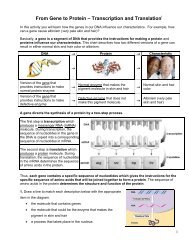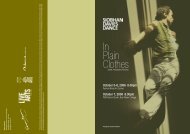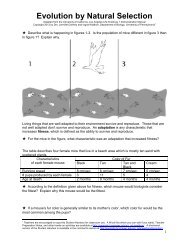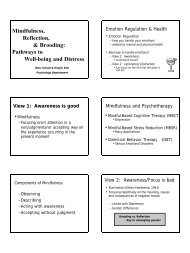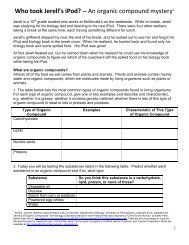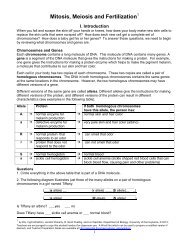Moldy Jell-O - Serendip
Moldy Jell-O - Serendip
Moldy Jell-O - Serendip
You also want an ePaper? Increase the reach of your titles
YUMPU automatically turns print PDFs into web optimized ePapers that Google loves.
<strong>Moldy</strong> <strong>Jell</strong>-Oadapted from “Fun with <strong>Moldy</strong> <strong>Jell</strong>-O” by Bob Farber at Central High School, Philadelphia;copyright 2004 by Dr. Ingrid Waldron, Dr. Mecky Pohlschroder, and Jennifer Doherty, Dept. Biology, University of Pennsylvania 1Green plants can make their own food from sunlight, air, and water. This processis called photosynthesis. In contrast, animals must eat to get food.Molds, mushrooms and other fungi seem like plants because they don’t move.However, fungi do not photosynthesize, so they cannot make their own food. Molds andother fungi often grow on decaying plant material, such as fruit, bread, and leaves. Thedecaying plant material provides the food for molds to grow.Molds grow well at room temperature, and many can also grow in the lowertemperature of home refrigerators. Sometimes, when you leave food in the refrigeratoror the kitchen too long and the food spoils, you can see mold growing on it. Thishappens because molds reproduce by spores that are light enough to float in the air –mold spores in the air in your kitchen will settle on food and then start to grow. Forexample, an orange can develop a spot of blue mold.In this laboratory you will design an experiment to evaluate how environmentalfactors influence the growth of molds. You can design your experiment to answer one ormore of the following questions, or another question of your own choosing (subject toinstructor approval).• Does mold grow faster at cold temperatures (in the refrigerator) or at warmtemperatures (in the room), or the same at both temperatures?• Does mold grow faster in the light or in the dark, or the same in both light anddark?• Does mold grow faster with just protein for food or with protein and sugar forfood?• Can mold grow on a substance that does not contain water?• Does the air in your classroom contain mold spores?Materials available for your experiment• plain gelatin powder (contains protein)• orange <strong>Jell</strong>-O powder (contains similar protein plus sugar and flavoring)• sugar• small cups of prepared gelatin and <strong>Jell</strong>-O (made from gelatin or <strong>Jell</strong>-O powderplus water)• clean Q-tips for transferring mold• aluminum foil and plastic wrap to cover cups• mold from bread, cheese, etc. (Please bring some from home if possible.)1Teachers are encouraged to copy this student handout for classroom use. A Word file (which can be used to prepare a modifiedversion if desired), Teacher Preparation Notes, comments, and the complete list of our hands-on activities are available athttp://serendip.brynmawr.edu/sci_edu/waldron/.
Laboratory Day 11. Your group should choose the question you want to answer, and design anexperiment that will help you answer this question. Construct a hypothesis about thequestion your group has decided to try to answer and write it in the space below.2. Think about how to design your experiment to answer your question as clearly aspossible.Plan to have a pair of experimental conditions that differ in only one characteristic.For example, to test the effects of temperature put exactly the same contents in allcups and keep them all in the dark, but keep some of the cups at a differenttemperature. That way you can identify the cause of any differences in mold growththat you observe.If you want to test the effects of two different factors on mold growth, you will need tohave two sets of cups; the first set of cups should all be the same except fordifferences in the first factor you are testing, while the second set of cups should allbe the same except for differences in the second factor you are testing.Also, you will want to have more than one mold growth cup in each experimentalcondition to see whether results are consistent for different mold growth cups underthe same condition. Use the chart below to provide a description of yourexperimental design.Cups 1 & 2CupContentsLocation forcupsCovering oncupsTemperature &other specificconditionsCups 3 & 4Additionalcups, ifdesired3. Once you have designed your experiment check with your teacher for suggestionsand approval.4. Set up your experiment. When applying the mold to your cups, use Q-tips and try toget the same amount of mold in each cup.
5. Plan how you will gather and record the data, using the chart shown below. Ifpossible, you should record mold growth and any other observations every day for 5days or longer.Fill in the Cup 1 Cup 2 Cup 3 Cup 4dates belowDay 1(today):Day 2:Day 3:Day 4:Day 5:Day 6:Day 7:6. Record your observations carefully over the next week.Laboratory Day 27. At the end of the week, record a final set of observations. Examine each cup with amagnifying glass.8. Discuss the results you obtained with your group. Compare all of the cups in a givenexperimental condition (e.g. all the cups at one temperature). Did you find the sameresult in all of the cups within each experimental condition? If you found differencesbetween cups in the same experimental condition, what might account for thesedifferences?What differences do you notice between the cups in different experimentalconditions? For example, did mold growth differ depending on temperature?9. Prepare a report on your experimental hypothesis, results, and interpretation for therest of the class.10. Based on the results from all of your class’s experiments on mold growth, what canyou conclude about the factors that influence mold growth? What can you concludeabout the best ways to store food?


